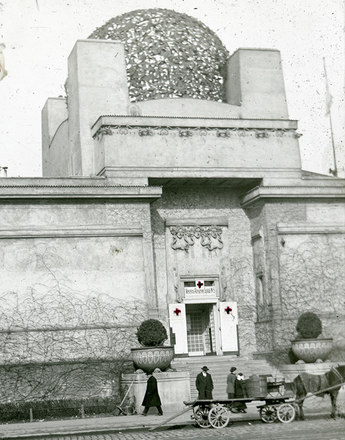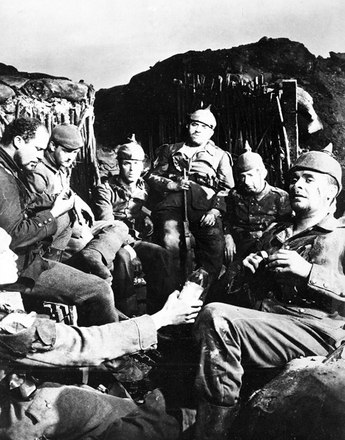‘Warriors on the Frozen Front’ – The War in the Alps as a Test of Manly Strengths
In the Austrians’ culture of memory in the post-war years the war in the Alps played a special role. The ‘steeled’ men battling against nature and the enemy appear as ‘martyr heroes’ and exemplary figures in a process of making sense of what had happened which attributes heroic traits, mythical qualities and symbolic capital to the soldiers of the Austro-Hungarian army despite their having been defeated. The ‘sons of the Alps’ – mountain warriors and Tyrolean militiamen who were exposed to indescribable hardships amid the rocks and snow of the Alpine front and had stood the test very well – corresponded particularly well to the ideal of tough military masculinity.
This hard core of masculinity is presented in the books which Fritz Weber, a writer who had fought in the war, produced on the basis of his memories in the early 1930s, among them Das Ende einer Armee (The End of an Army) (1931), Granaten und Lawinen (Grenades and Avalanches) (1932), Frontkameraden (Comrades at the Front ) (1935). His texts construct an ideologically coloured masculinity based not only on strength, courage, valour and the readiness to make sacrifices, but also on ‘iron nerves’ and the ability to endure indescribable tension: ‘There is a roar in your ears, the veins in your pupils are bursting, blood is coming out of your eyes. From time to time you feel sick and must drink some rum to be able to continue to endure it.’ Weber gives several examples of ‘unprecedented heroism’, which pour scorn on the notion of modern warfare being determined by chance and technology and glorify the ancient way of fighting man to man: ‘Eye to eye with unknown faces distorted by nervousness, raging with knife, club, spade and rifle butt, with every weapon, indeed with bare hands which clench around your opponent’s throat.’ Small-scale encounters with the enemy are depicted as more exciting than the great battles because they give mountain soldiers who have been conditioned to die a hero’s death the opportunity to realise the idea of war as a matter of adventure and chivalry. Weber’s archaic-modern heroes are stylized as the only real examples of true masculinity, representing a privileged élite, the ‘martyrs of steadfastness’ who have proved their worth ‘in rock and ice’: there is nothing which can undermine their masculine identity. It follows that these men can, in Weber’s vision of the future, also attain the ‘pinnacle of masculinity’ in peacetime.
The superiority of the brave Alpine warriors to the soldiers on other fronts is also a theme in the writings of Luis Trenker, who was sent to fight in the Dolomites and afterwards worked on the myth of the mountain war. In 1931 Trenker published the novel Berge in Flammen (Mountains in Flames) – later turned into a successful film – in which the protagonist, Florian Dimai, a mountaineer and war hero whose central attributes are strength, audacity and cunning, takes enormous risk to achieve a great individual deed which influences the course of the war and saves his comrades from certain death. Trenker tells of a tough confrontation with the enemy and the mountain environment (‘At the mercy of death by iron and avalanche, cold and storm, rock fall, lightning and fatal falls’), of masculine friendship which outlasts the war because it is based on mutual love for the mountains, and last but not least of love, longing for mother, wife, child and of the close ties with home. Just how strongly heroic masculinity is emotionalized is shown by the scene where Dimai takes leave of his wife: ‘A hard hand wipes eyes wet with tears. Dimai was weeping. Nobody saw. He was on the point of a breakdown. But the comrades were waiting.’
The ‘soft’ disposition of the Austrian heroes means that they do not cast off their social roles as sons, fathers, partners and lovers, but much rather suffer as a result of the emotional deficit when they are at the front. The idea of the war ending and a happy return home is a highly attractive one for even the bravest and toughest men.
Translation: Leigh Bailey
Eisterer, Klaus/Steininger, Rolf (Hrsg.): Tirol und der Erste Weltkrieg. Innsbruck/Wien 1995
Kuprian, Hermann J. W./Überegger, Oswald (Hrsg.): Der Erste Weltkrieg im Alpenraum. Erfahrung, Deutung, Erinnerung, Innsbruck 2006
Waldner, Hansjörg: „Deutschland blickt auf uns Tiroler“. Südtirolromane zwischen 1918 und 1945, Wien 1990
-
Chapters
- Dreamers Who Turn into Heroes
- ‘Warriors on the Frozen Front’ – The War in the Alps as a Test of Manly Strengths
- The War as a ‘Technoromantic Adventure’
- Forms of Masculinity – Hierarchies, Rivals, Competitors
- Melancholy Men in Uniform – How Masculinity Becomes a Problem
- ‘Black Decay’ – Soldiers as Victims
- ‘The Flight Without End’? – The Warrior’s Homecoming
- ‘A New Race of Men’? – Ideologies of Masculinity in Post-War Austria





